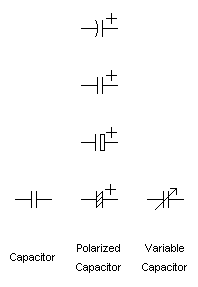Electronics notes/Capacitors
Intro

Capacitors (regularly abbreviated as caps) take an electrostatic charge, which (ignoring leakage) will remain until discharged.
When you put DC across them, they charge to that voltage.
They work as a sort of battery - with tiny capacity, but enough for a number of practical uses.
When you put AC across them, limited charging speed means they work more like frequency-dependent resistors, as in oppose some frequencies more than others, which is why they help build signal conditioning, noise reduction, filtering, and resonant circuits.
Some theory and behaviour
Charging and discharging
See also:
Capacitor marking
Rating considerations
Voltage
You'll often know the maximum voltage a capacitor will be exposed to, though you may wish to consider your circuit's ripple current, peak current, fault current, possible voltage reversal, and more.
The voltage spec seems a nominal one, in that it can probably handle more, but you may shorten its lifespan, and with significantly more you will make it fail.
Temperature (spec / behaviour)
Dielectrics / types / designs
Electrolytic capacitors (type)

- polarized - reverse biasing these will cause an electrochemical reaction in the electrolyte, causing it to heat, expand, vent, and likely short in the process. The common cylinder shape has indentations on the top that will bulge and fold open (a safety feature, and one that makes failed electrolytic caps easy enough to identify)
- higher inductance than many other types, so not so useful for high-frequency applications
- cheap, so common wherever the frequency or stability limitations are not a problem
- often can-shaped, and regularly black, grey, blue, and with a stripe indicating its negative lead
- Capacitors with more than ~1µF are regularly electrolytic capacitors because of cost. Other types are also used, but often when electrolytic's polarization or lower stability is a problem.
Ceramic capacitors (type)

http://en.wikipedia.org/wiki/Ceramic_capacitor
Tantalum capacitors (type)
- http://images.google.com/images?q=tantalum%20capacitors
- http://commons.wikimedia.org/w/index.php?title=Special%3ASearch&search=tantalum+capacitor
- http://images.google.com/images?q=SMD+tantalum+capacitor
Silver mica capacitors (type)
http://en.wikipedia.org/wiki/Silver_mica_capacitor
Plastic film
See also (types)
Variable Capacitor (design)
Adjustable capacitors, often looking similar to potmeters (and frequently like trimpots).
Specializations
EMI/RFI suppression (spec)
Pulse capacitor
More applied
Gimmick (design)
Bypass capacitor (application)
De-coupling and coupling capacitor (application)
Power supply filtering (application)
Lowpass filter (application)
Signal generator (application)
Capacitive dropper (application)
See Electronics_notes/Changing_voltage#capacitive_dropper
Motor capacitor (application)
See also
- http://www.educypedia.be/electronics/capacitorstypes.htm
- http://www.satcure-focus.com/tutor/page6.htm